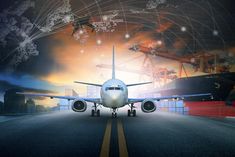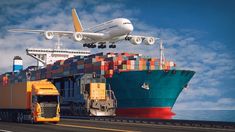Air transportation is an essential component of the global economy. It connects people and businesses all over the world, allowing for unprecedented trade and commerce. In recent years, air travel has changed dramatically, with an increasing number of people flying to international destinations every day. And, as air travel grows in popularity, so does the demand for efficient and dependable air transportation systems. In this blog post, we'll look at the current state of air travel in China and how it's affecting the global economy. We'll also look at some of the industry's upcoming challenges and what businesses can do to stay competitive.
For centuries, China has been a major air transportation hub. China was an ideal location for early air travel due to its unique geography and abundance of water. The first recorded flight in China occurred in 1796, when an aerial balloon transporting the French ambassador left Beijing for Guangzhou.
The first Chinese-made airplane took off from Shanghai and flew to Wuhan in 1876. A Chinese pilot flew the country's first airplane across the Pacific Ocean from Shanghai to San Francisco in 1903. During the Qing Dynasty (1644-1911), aviation grew rapidly in popularity in China because Emperor Pu Yi was a noted enthusiast who funded extensive research into aviation technology. By 1911, China had over 1,000 registered airplanes, making it one of the world's leading aviation nations at the time.
During WWII, however, Japan occupied much of China and cut off all access to Western aircraft technology. This prevented China from developing its own advanced aviation industry and limited domestic air travel until 1945, when WWII ended. Because of its burgeoning population and growing economic prosperity after WWII, many Western aviation companies began establishing operations in postwar China. This influx of new technology resulted in rapid growth in Chinese aviation over the next several decades, with annual passenger traffic exceeding one million by 1969. However, after Mao Zedong's Cultural Revolution (1966-1976), which disrupted transportation and other sectors of society throughout the country, this growth slowed significantly.

Air Transportation China to worldwide has advanced significantly in recent decades. China had only five domestic airlines in 1978. By the year 2000, the figure had risen to 38. In 2013, there were 54 airlines in operation in China. This expansion is due, in part, to the country's large population and expanding economy.
Domestic air travel is primarily restricted to residents of China's mainland. Foreign tourists can, however, obtain Beijing-based visas on arrival for short-term visits. Foreign airlines must have a valid Civil Aviation Administration of China (CAAC) license and must follow Chinese customs and immigration regulations. There are no direct flights from Taiwan to mainland China at the moment, but cross-strait flights via Hong Kong are possible.
The majority of Chinese airlines have their headquarters in major cities like Beijing, Shanghai, Guangzhou, and Shenzhen. Airlines also fly from secondary hubs in Chengdu and Wuhan. Air China is China's largest airline, with over 900 flights per day to over 60 destinations worldwide. Hainan Airlines (owned by the State Grid Corporation of China), Shanghai Airlines, Shenzhen Airlines, and Tianjin Airlines are among the other well-known carriers.
Air transportation contributes significantly to the country's economy...

China's aviation industry is thriving, with numerous airlines serving domestic and international destinations. To meet the growing demand for air travel, the country's airports are rapidly expanding.
Delta Air Lines has grown to become China's leading airline, serving over 100 destinations in Asia, Australia, Air Transportation China to Europe, and North America. The airline has formed a global alliance with China Southern Airlines to provide even more flights and connections between the United States and China. Beijing Capital Aviation Company (BCAC), Hong Kong Airlines, KLM Royal Dutch Airlines, Japan Airlines (JAL), Shanghai Airlines, Singapore Airlines, and Thai Airways are among China's other major airlines.
There are now over 300 airports in the country that can handle jet aircraft. Domestic flights typically depart from major cities such as Beijing, Shanghai, Guangzhou, Shenzhen, Chengdu, and Hangzhou, while international flights generally depart from hubs such as Hong Kong International Airport, Beijing Capital Airport, and Shanghai Pudong International Airport.

Airports in China
There are numerous airports in China. Beijing Capital International Airport is the busiest, with over 54 million passengers served in 2016. Shanghai Pudong International Airport, Guangzhou Baiyun International Airport, and Shenzhen Bao'an International Airport are among the other major airports. In addition, there are numerous regional airports located throughout the country.
China intends to spend approximately US$130 billion on new airport projects in 2016. Construction of new hubs, such as Dalian Wuhan International Airport and Chengdu Shuangliu International Airport, as well as upgrades to existing airports, will be undertaken.
In addition, the government intends to make air travel more affordable by instituting new tariffs and lowering ticket prices on specific routes. Furthermore, the government encourages private companies to invest in aviation and develop new aircraft models.
Matic Express was established in 2007. The company's headquarters are in Shenzhen, China. Our primary business is with Changsha Chaintech Supply Chian Management Co, Ltd, a branch of Changsha China. We specialize in air and sea shipping, express, railroad, and truck shipping, as well as truck shipping on DDP, DDU, FLC, or LCL terms. We ship to Amazon warehouses as well as international warehouses.
Matic Express provides international freight shipments via air, sea, and truck. Pick up, delivery, amazon label, booking, placing, customs clearance, and local delivery to your doorstep are among the services we provide in the United States, Australia, Canada, France, Germany, Poland, Italy, Spain, Japan, New Zealand, and the United Arab Emirates, among others.
Matic Express can provide door to door delivery shipping whether you are looking for sea freight or rail express truck shipping DDP and DDU of the doorstep, which some small customers prefer. If you need items shipped from China to your location, we can arrange door-to-door service.
Matic Express has its own warehouses to store your cargo. These warehouses can be located in Shenzhen Yiwu Ningbo Shanghai Guangzhou Guangzhou Dalian Chongqing, Guangzhou Guangzhou Shanghai Guangzhou Guangzhou Guangzhou Shanghai Guangzhou Guangzhou Guangzhou Guangzhou Guangzhou Guangzhou Guangzhou Guangzhou Guangzhou Guangzhou Guangzhu Shanghai Guangzhou Guangzhou Guangzhou Guangzhou Guangzhou Dalian We'll take it to your warehouse. Our warehouse can be supplied by your suppliers or you. We offer services like inspection of cargo and stick labels, weighing size and weight, and delivery service.